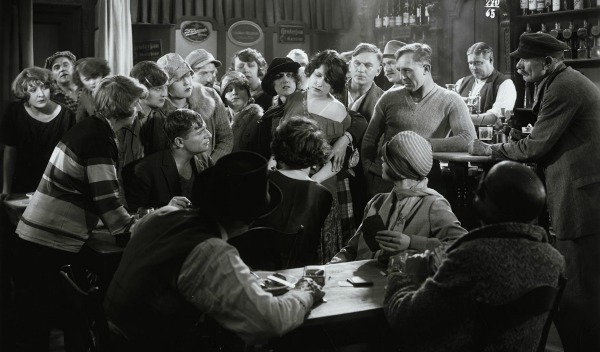Multi-storied and multi-storeyed apartment-set drama which brings together a variety of social classes and film genres in a satisfying whole.
At the beginning of Gerhard Lamprecht’s PEOPLE TO EACH OTHER, a local gossip, Frau Mierig, introduces the recently-installed housekeeper of an apartment block to her new charges via a conveniently visual cue – the board listing the residents’ names and room numbers. On the lower floors live the most respectable individuals: a busy lawyer, a wealthy jeweller, an ambitious government official. With each new floor, the occupants are reduced in social standing, financial means or both. The often interconnected stories of a number of these residents are told throughout the film. Mierig and the housekeeper, Frau Kaminski, continue to observe the goings-on from the sidelines. As the first says to her new friend, ‘I told you this was an interesting house!’
Even if the current narrative is a bit dull, there’s always another one on its way.
Lamprecht divides his film into eight ‘acts’. Despite the literal compartmentalisation of his characters, however, this does not imply that each act refers to a self-contained narrative. Indeed, as the title suggests, the interaction between the residents is the film’s over-arching theme. Like many films running stories in parallel, PEOPLE TO EACH OTHER is inevitably uneven – the advantage of the form being that even if the current narrative is a bit dull, there’s always another, maybe more interesting one on its way.
Even so, it does seem a pity that the most prominent story in the film also feels like the weakest. In this, Gertrud, the wife of one of the residents, the government official Helmuth Köhler (Alfred Abel, best known as Joh Fredersen in METROPOLIS), and the daughter of his downstairs neighbour, the jeweller Rudloff, has been sent to prison for manslaughter after a car accident, and has just given birth there. The child, as the law of the time requires, must be separated from its mother and removed from prison. Her husband, his reputation in ruins and his political ambitions dashed, cannot bring himself to forgive or even visit her. As the time for the child to be taken away from her approaches, Gertrud becomes understandably agitated, and her father attempts to speed up her parole on the grounds of her worsening mental state. While it would be tempting to read a measure of satire into this story’s set-up – Helmuth marrying a rich man’s daughter to aid his political ambitions, Gertrud conveniently oblivious to her own, hardly negligible crime – this does not seem to be Lamprecht’s intention. His main concern is the cruelty of the ‘regulations’ in parting mother from child.
In a parallel but much slighter storyline, an act of kindness by Rudloff towards a neighbour, prompted by his dutiful younger daughter Brigitte, leads to her own romantic adventure with the son of an aristocratic but penniless widow. Rudloff’s unfailing generosity – is it a coincidence that Eduard Rothauser, who plays him, was one of the film’s three writers? – is in marked contrast to the actions of the film’s other very wealthy character, Frau Büttner. First seen counting her money while smoking a huge cigar, Büttner, the house’s widowed owner and the film’s unabashed villain, is also the protagonist of its second main story, seeking the services of one of her lessees – a sly and matronly matchmaker rejoicing in the name of Ria Ricarda Roda – and getting a little too involved with an Australian diamond-broker who may not be all he seems.
The sort of vivacious, full-body pantomime that is one of the true pleasures of silent cinema.
In contrast to the over-extended pathos and melodrama of the Köhlers’ story, Lamprecht seems on surer ground with Frau Büttner. Erika Glässner plays her with the sort of vivacious, full-body pantomime that is one of the true pleasures of silent cinema. Lamprecht clearly relishes the opportunities for satire that her greed, callousness, lubriciousness and stupidity afford. A highlight of this storyline is Frau Roda’s sleazy soirée, where Büttner meets her supposedly ardent Australian. Here Lamprecht’s gift for cynically telling details finds full expression: predatory grotesques of both sexes eye each other up with barely concealed cupidity, or gaze enviously at someone else’s better-looking date; in the kitchen, one of Frau Roda’s minions attaches expensive wine labels to cheap bottles with contemptuous ease; incongruously, a small boy with a pencil moustache and a dolled-up poppet ape their elders. At one point a partygoer says, ‘Do you come here often?’, which must be one of the first appearances on film of that hoary pick-up line. Not long afterward, Frau Büttner even gets to invite her new beau in ‘for coffee’ – surely another screen first.
Meanwhile, on the ground floor, the housekeeper and her husband entertain Frau Mierig and a friend who has purloined some of the food from the party above. This scene of quiet, unforced community provides a very effective contrast, and its theme is echoed throughout the film by vignettes showing neighbour helping neighbour.
True to Lamprecht’s interest in presenting the social realities of the time, many of his performers have refreshingly ordinary features. It is noticeable, however, that the higher the social scale, the more ‘actorly’ the faces. Eduard Rothauser as Rudloff, for instance, is the possessor of a truly magnificent profile which could go head-to-head with John Barrymore’s, while Aud Egede-Nissen, as the incarcerated Gertrud, has the sort of eyes, cheekbones and mouth that practically scream ‘tragedienne’.
When it comes to the style of filming, Lamprecht mostly plays it straight, avoiding the virtuosic ‘unchained camera’ techniques of his German contemporaries like Murnau and Lang. The one exception is a kinetic bit of business towards the end where the widow Büttner races to restore her fortune, and he cuts between her unexpectedly dainty feet running along the pavement, and speeded-up travelling shots of the city’s shopfronts.


